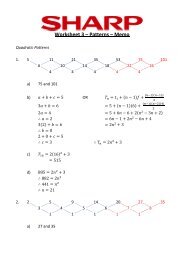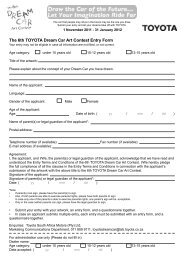curriculum and assessment policy statement (caps) - Department of ...
curriculum and assessment policy statement (caps) - Department of ...
curriculum and assessment policy statement (caps) - Department of ...
- No tags were found...
Create successful ePaper yourself
Turn your PDF publications into a flip-book with our unique Google optimized e-Paper software.
Content Area Content Clarification / Notes / Activities / Examples Recommended ResourcesApproximateDurationSuggested FormalAssessmentContinued ‣ The teacher says a house number, address or telephone number<strong>of</strong> a learner. The learner whose number or address it is mustrespond.‣ When completing the attendance register the teacher may askquestions such as: “Is the learner with the telephone number435-6256 here today?” “Is the learner that lives in M<strong>and</strong>ela drive123 here today?”‣ Learners use number symbol flash cards to pack their housenumber or telephone number in sequence.‣ Role-play conversations on a play telephone. Learners phonesomeone special.Space <strong>and</strong> Shape Build 3-D objects • Let learners build own construction by copying from a givenconstruction exampleMeasurement Length • Estimate the length <strong>of</strong> different objectsKinaesthetic‣ Learners arrange themselves from shortest to tallest. Comparetheir height with the heights <strong>of</strong> their friends.‣ Play “Follow the leader” games. The tallest performs an actionwhile others behind him/her copy. Turn the whole row around sothe shortest now is the leader.‣ Let learners compare their h<strong>and</strong>s <strong>and</strong> feet to see whose are thelongest/shortest.Estimate <strong>and</strong> then measure:‣ Learners estimate which object is long <strong>and</strong> which one is shorte.g. the length <strong>of</strong> the table or the piece <strong>of</strong> string.‣ Estimate which object is the longest or shortest e.g. the pencil orthe wax crayon.‣ Let learners guess which objects would be longer e.g. 2 strawslaid end-to-end or three paperclips laid end -to-end.‣ Pose question such as: “Which is longer/longest, the pencil orthe piece <strong>of</strong> string?” etc.‣ Which chair is the farthest away from the teacher’s desk?‣ How many pencils can fit on the long side <strong>of</strong> the teacher’s desk?‣ How many steps do you have to take to the door?‣ How many matchboxes, filled with s<strong>and</strong>, will fill this box?‣ How many egg-cups full <strong>of</strong> water will fill this glass?‣ Here are four learners <strong>and</strong> three chairs. How many more chairsdo we need?The telephone number should be the contactnumber <strong>of</strong> the parent or guardian <strong>and</strong> could be a cellphone numberAttendance registerNumber symbol flash cardsorLarge number symbols made from cardboardPlay telephoneBuilding blocksLego blocksAny other construction equipment.Objects with different lengths such as:Pencils, wax crayon, pieces <strong>of</strong> string (<strong>of</strong> which one iscurled up), table, books, straws, paperclips (foldedopen <strong>and</strong> curled up) etc.1 dayThereafterongoing2 daysorOnly select afew activitiesData H<strong>and</strong>lingCollect <strong>and</strong> sortobjects (alone <strong>and</strong>/oras a member <strong>of</strong> agroup or team) in theenvironment• Introduce the concept <strong>of</strong> data h<strong>and</strong>ling by collecting objects inthe class or environment according to stated features forexample:‣ Collect items in the classroom <strong>and</strong> sort them according to specific Objects collected in the classroom such as books,1 day51 | P age
















